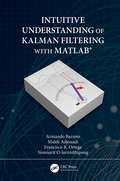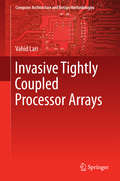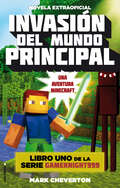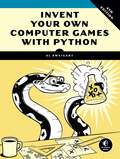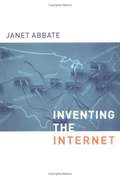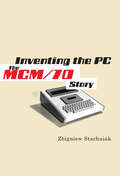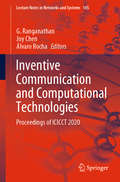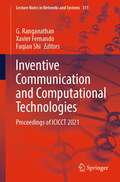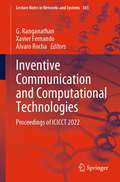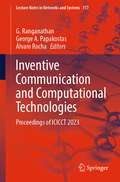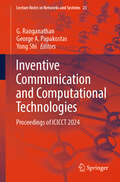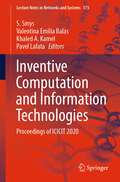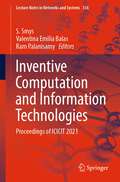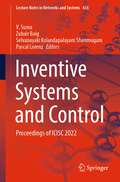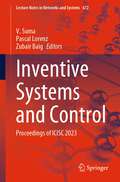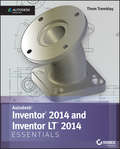- Table View
- List View
Intuitive Interaction: Research and Application
by Alethea BlacklerThis book explores recent research in intuitive interaction worldwide by a range of leading academics and practitioners in the field. It builds on past work as it ventures into new areas, such as how users perceive intuitiveness of an interface, how people experience intuitive interaction subjectively, and how we can use such understanding to design more engaging experiences. The book addresses how intuitive interaction is understood in different academic disciplines and how it has been researched in various parts of the world over the last 18 years. It covers how intuitive interaction can be applied in different contexts, like large scale urban installations, the developing world, in older populations, and in various industry applications. <P><P>Features: <li>Presents varied approaches to intuitive interaction research and application <li>Illustrates how to understand and apply intuitive interaction to interfaces <li>Provides a mix of academic and industry perspectives <li>Explores a variety of contexts for application of intuitive interaction <li>Encompasses design, IT, business, and psychological approaches
Intuitive Understanding of Kalman Filtering with MATLAB®
by Francisco R. Ortega Armando Barreto Malek Adjouadi Nonnarit O-larnnithipongThe emergence of affordable micro sensors, such as MEMS Inertial Measurement Systems, are applied in embedded systems and Internet-of-Things devices. This has brought techniques such as Kalman Filtering, which are capable of combining information from multiple sensors or sources, to the interest of students and hobbyists. This book will explore the necessary background concepts, helping a much wider audience of readers develop an understanding and intuition that will enable them to follow the explanation for the Kalman Filtering algorithm. Key Features: Provides intuitive understanding of Kalman Filtering approach Succinct overview of concepts to enhance accessibility and appeal to a wide audience Interactive learning techniques with code examples Malek Adjouadi, PhD, is Ware Professor with the Department of Electrical and Computer Engineering at Florida International University, Miami. He received his PhD from the Electrical Engineering Department at the University of Florida, Gainesville. He is the Founding Director of the Center for Advanced Technology and Education funded by the National Science Foundation. His earlier work on computer vision to help persons with blindness led to his testimony to the U.S. Senate on the committee of Veterans Affairs on the subject of technology to help persons with disabilities. His research interests are in imaging, signal processing and machine learning, with applications in brain research and assistive technology. Armando Barreto, PhD, is Professor of the Electrical and Computer Engineering Department at Florida International University, Miami, as well as the Director of FIU’s Digital Signal Processing Laboratory, with more than 25 years of experience teaching DSP to undergraduate and graduate students. He earned his PhD in electrical engineering from the University of Florida, Gainesville. His work has focused on applying DSP techniques to the facilitation of human-computer interactions, particularly for the benefit of individuals with disabilities. He has developed human-computer interfaces based on the processing of signals and has developed a system that adds spatialized sounds to the icons in a computer interface to facilitate access by individuals with "low vision." With his research team, he has explored the use of Magnetic, Angular-Rate and Gravity (MARG) sensor modules and Inertial Measurement Units (IMUs) for human-computer interaction applications. He is a senior member of the Institute of Electrical and Electronics Engineers (IEEE) and the Association for Computing Machinery (ACM). Francisco R. Ortega, PhD, is an Assistant Professor at Colorado State University and Director of the Natural User Interaction Lab (NUILAB). Dr. Ortega earned his PhD in Computer Science (CS) in the field of Human-Computer Interaction (HCI) and 3D User Interfaces (3DUI) from Florida International University (FIU). He also held a position of Post-Doc and Visiting Assistant Professor at FIU. His main research area focuses on improving user interaction in 3DUI by (a) eliciting (hand and full-body) gesture and multimodal interactions, (b) developing techniques for multimodal interaction, and (c) developing interactive multimodal recognition systems. His secondary research aims to discover how to increase interest for CS in non-CS entry-level college students via virtual and augmented reality games. His research has resulted in multiple peer-reviewed publications in venues such as ACM ISS, ACM SUI, and IEEE 3DUI, among others. He is the first-author of the CRC Press book Interaction Design for 3D User Interfaces: The World of Modern Input Devices for Research, Applications and Game Development. Nonnarit O-larnnithipong, PhD, is an Instructor at Florida International University. Dr. O-larnnithipong earned his PhD in Electrical Engineering, majoring in Digital Signal Processing from Florida International Unive
Invariants of Behavior
by Mario NegrelloThe study of the brain and behavior is illuminated with the discovery of invariances. Experimental brain research uncovers constancies amidst variation, with respect to interventions and transformations prescribed by experimental paradigms. Place cells, mirror neurons, event related potentials and areas differentially active in fMRI, all illustrate the pervasive role of invariances in neural systems in relation to their function.
Invasive Tightly Coupled Processor Arrays
by Vahid LariThis book introduces new massively parallel computer (MPSoC) architectures called invasive tightly coupled processor arrays. It proposes strategies, architecture designs, and programming interfaces for invasive TCPAs that allow invading and subsequently executing loop programs with strict requirements or guarantees of non-functional execution qualities such as performance, power consumption, and reliability. For the first time, such a configurable processor array architecture consisting of locally interconnected VLIW processing elements can be claimed by programs, either in full or in part, using the principle of invasive computing. Invasive TCPAs provide unprecedented energy efficiency for the parallel execution of nested loop programs by avoiding any global memory access such as GPUs and may even support loops with complex dependencies such as loop-carried dependencies that are not amenable to parallel execution on GPUs. For this purpose, the book proposes different invasion strategies for claiming a desired number of processing elements (PEs) or region within a TCPA exclusively for an application according to performance requirements. It not only presents models for implementing invasion strategies in hardware, but also proposes two distinct design flavors for dedicated hardware components to support invasion control on TCPAs.
Invasión del mundo principal: Una aventura Minecraft (Gameknight999 #Volumen 1)
by Mark ChevertonA Gameknight999 le mola Minecraft, pero por encima de todo le gusta grifear y arruinar la partida a otros jugadores. -Novela extraoficial- Cuando uno de los inventos creados por su padre le teletransporta dentro de Minecraft, Gameknight se encuentra con una aventura real en medio de un mundo digital. ¿Qué pasaría si le mataran? ¿Moriría en la vida real?Metido en el juego, Gameknight descubre el secreto mejor guardado de Minecraft, algo de lo que aún no se han dado cuenta ni los programadores del juego: ¡las criaturas que allí habitan están verdaderamente vivas! Evitando ser atrapado por las garras afiladas de los zombis y los puntiagudos colmillos de las arañas, Gameknight deberá aprender a hacer amigos y a entender la importancia del trabajo en equipo para poder sobrevivir a la guerra Minecraft que acaba de comenzar. La crítica ha dicho...«Estas aventuras adictivas encantarán a los fans Minecraft y les llenará de valor y coraje al igual que cuando juegan delante de la pantalla.»Parents in Touch«Este libro nos enseña un mensaje muy claro, que hay libros que pueden leer tanto niños como adultos de todo el mundo. Muy recomendable y entretenido.»Midwest Book Review
Invent Your Own Computer Games with Python, 4E
by Al SweigartInvent Your Own Computer Games with Python will teach you how to make computer games using the popular Python programming language—even if you’ve never programmed before!Begin by building classic games like Hangman, Guess the Number, and Tic-Tac-Toe, and then work your way up to more advanced games, like a text-based treasure hunting game and an animated collision-dodging game with sound effects. Along the way, you’ll learn key programming and math concepts that will help you take your game programming to the next level.Learn how to:–Combine loops, variables, and flow control statements into real working programs–Choose the right data structures for the job, such as lists, dictionaries, and tuples–Add graphics and animation to your games with the pygame module–Handle keyboard and mouse input–Program simple artificial intelligence so you can play against the computer–Use cryptography to convert text messages into secret code–Debug your programs and find common errorsAs you work through each game, you’ll build a solid foundation in Python and an understanding of computer science fundamentals.What new game will you create with the power of Python?The projects in this book are compatible with Python 3.
Inventing the Internet
by Janet AbbateSince the late 1960s the Internet has grown from a single experimental network serving a dozen sites in the United States to a network of networks linking millions of computers worldwide. In Inventing the Internet, Janet Abbate recounts the key players and technologies that allowed the Internet to develop; but her main focus is always on the social and cultural factors that influenced the Internets design and use. The story she unfolds is an often twisting tale of collaboration and conflict among a remarkable variety of players, including government and military agencies, computer scientists in academia and industry, graduate students, telecommunications companies, standards organizations, and network users. The story starts with the early networking breakthroughs formulated in Cold War think tanks and realized in the Defense Department's creation of the ARPANET. It ends with the emergence of the Internet and its rapid and seemingly chaotic growth. Abbate looks at how academic and military influences and attitudes shaped both networks; how the usual lines between producer and user of a technology were crossed with interesting and unique results; and how later users invented their own very successful applications, such as electronic mail and the World Wide Web. She concludes that such applications continue the trend of decentralized, user-driven development that has characterized the Internet's entire history and that the key to the Internet's success has been a commitment to flexibility and diversity, both in technical design and in organizational culture.
Inventing the PC
by Zbigniew StachniakInventing the PC details the invention and design of the MCM/70 computer and the prolonged struggle to bring it to market. Zbigniew Stachniak offers an insider's view of events on the front lines of pioneering work on personal computers. He shows what information and options PC pioneers had, how well they understood what they were doing, and how that understanding - or lack thereof - shaped both their engineering ingenuity and the indecisiveness and over-reaching ambition that would ultimately turn a very promising venture into a missed opportunity. Providing comprehensive historical background and rich photographic documentation, Inventing the PC tells the story of a Canadian company on the cutting-edge of the information age.
Inventing the PC: The MCM/70 Story
by Zbigniew StachniakInventing the PC details the invention and design of the MCM/70 computer and the prolonged struggle to bring it to market. Zbigniew Stachniak offers an insider's view of events on the front lines of pioneering work on personal computers. He shows what information and options PC pioneers had, how well they understood what they were doing, and how that understanding - or lack thereof - shaped both their engineering ingenuity and the indecisiveness and over-reaching ambition that would ultimately turn a very promising venture into a missed opportunity. Providing comprehensive historical background and rich photographic documentation, Inventing the PC tells the story of a Canadian company on the cutting-edge of the information age.
Inventive Communication and Computational Technologies: Proceedings of ICICCT 2019 (Lecture Notes in Networks and Systems #89)
by Álvaro Rocha Joy Chen G. RanganathanThis book gathers selected papers presented at the Inventive Communication and Computational Technologies conference (ICICCT 2019), held on 29–30 April 2019 at Gnanamani College of Technology, Tamil Nadu, India. The respective contributions highlight recent research efforts and advances in a new paradigm called ISMAC (IoT in Social, Mobile, Analytics and Cloud contexts). Topics covered include the Internet of Things, Social Networks, Mobile Communications, Big Data Analytics, Bio-inspired Computing and Cloud Computing. The book is chiefly intended for academics and practitioners working to resolve practical issues in this area.
Inventive Communication and Computational Technologies: Proceedings of ICICCT 2020 (Lecture Notes in Networks and Systems #145)
by Álvaro Rocha Joy Chen G. RanganathanThis book gathers selected papers presented at the 4th International Conference on Inventive Communication and Computational Technologies (ICICCT 2020), held on 28–29 May 2020 at Gnanamani College of Technology, Tamil Nadu, India. The respective contributions highlight recent research efforts and advances in a new paradigm called ISMAC (IoT in Social, Mobile, Analytics and Cloud contexts). The topics covered include the Internet of Things, Social Networks, Mobile Communications, Big Data Analytics, Bio-inspired Computing and Cloud Computing. Given its scope, the book is chiefly intended for academics and practitioners working to resolve practical issues in this area.
Inventive Communication and Computational Technologies: Proceedings of ICICCT 2021 (Lecture Notes in Networks and Systems #311)
by Xavier Fernando Fuqian Shi G. RanganathanThis book gathers selected papers presented at the Inventive Communication and Computational Technologies conference (ICICCT 2021), held on 25–26 June 2021 at Gnanamani College of Technology, Tamil Nadu, India. The book covers the topics such as Internet of things, social networks, mobile communications, big data analytics, bio-inspired computing, and cloud computing. The book is exclusively intended for academics and practitioners working to resolve practical issues in this area.
Inventive Communication and Computational Technologies: Proceedings of ICICCT 2022 (Lecture Notes in Networks and Systems #383)
by Álvaro Rocha Xavier Fernando G. RanganathanThis book gathers selected papers presented at the Inventive Communication and Computational Technologies Conference (ICICCT 2022), held on May 12–13, 2022, at Gnanamani College of Technology, Tamil Nadu, India. The book covers the topics such as Internet of Things, social networks, mobile communications, big data analytics, bio-inspired computing, and cloud computing. The book is exclusively intended for academics and practitioners working to resolve practical issues in this area.
Inventive Communication and Computational Technologies: Proceedings of ICICCT 2023 (Lecture Notes in Networks and Systems #757)
by Álvaro Rocha G. Ranganathan George A. PapakostasThis book gathers selected papers presented at the 7th International Conference on Inventive Communication and Computational Technologies conference (ICICCT 2023), held on May 22–23, 2023, at Gnanamani College of Technology, Tamil Nadu, India. The book covers the topics such as Internet of things, social networks, mobile communications, big data analytics, bio-inspired computing and cloud computing. The book is exclusively intended for academics and practitioners working to resolve practical issues in this area.
Inventive Communication and Computational Technologies: Proceedings of ICICCT 2024 (Lecture Notes in Networks and Systems #23)
by Yong Shi G. Ranganathan George A. PapakostasThis book gathers selected papers presented at the 8th International Conference on Inventive Communication and Computational Technologies (ICICCT 2024), held on June 14–15, 2024, at Sree Sakthi Engineering College, Coimbatore, India. The book covers the topics such as Internet of things, social networks, mobile communications, big data analytics, bio-inspired computing, and cloud computing. The book is exclusively intended for academics and practitioners working to resolve practical issues in this area.
Inventive Computation Technologies (Lecture Notes in Networks and Systems #98)
by Álvaro Rocha S. Smys Robert BestakWith the intriguing development of technologies in several industries, along with the advent of ubiquitous computational resources, there are now ample opportunities to develop innovative computational technologies in order to solve a wide range of issues concerning uncertainty, imprecision, and vagueness in various real-life problems. The challenge of blending modern computational techniques with traditional computing methods has inspired researchers and academics alike to focus on developing innovative computational techniques. In the near future, computational techniques may provide vital solutions by effectively using evolving technologies such as computer vision, natural language processing, deep learning, machine learning, scientific computing, and computational vision. A vast number of intelligent computational algorithms are emerging, along with increasing computational power, which has significantly expanded the potential for developing intelligent applications. These proceedings of the International Conference on Inventive Computation Technologies [ICICT 2019] cover innovative computing applications in the areas of data mining, big data processing, information management, and security.
Inventive Computation and Information Technologies: Proceedings of ICICIT 2020 (Lecture Notes in Networks and Systems #173)
by Valentina Emilia Balas S. Smys Pavel Lafata Khaled A. KamelThis book is a collection of best selected papers presented at the International Conference on Inventive Computation and Information Technologies (ICICIT 2020), organized during 24–25 September 2020. The book includes papers in the research area of information sciences and communication engineering. The book presents novel and innovative research results in theory, methodology and applications of communication engineering and information technologies.
Inventive Computation and Information Technologies: Proceedings of ICICIT 2021 (Lecture Notes in Networks and Systems #336)
by Valentina Emilia Balas S. Smys Ram PalanisamyThis book is a collection of best selected papers presented at the International Conference on Inventive Computation and Information Technologies (ICICIT 2021), organized during 12–13 August 2021. The book includes papers in the research area of information sciences and communication engineering. The book presents novel and innovative research results in theory, methodology and applications of communication engineering and information technologies.
Inventive Computation and Information Technologies: Proceedings of ICICIT 2022 (Lecture Notes in Networks and Systems #563)
by S. Smys Ram Palanisamy Khaled A. KamelThis book is a collection of best selected papers presented at the Fourth International Conference on Inventive Computation and Information Technologies (ICICIT 2022), organized during August 25–26, 2022. This book includes papers in the research area of information sciences and communication engineering. This book presents novel and innovative research results in theory, methodology and applications of communication engineering and information technologies.
Inventive Systems and Control: Proceedings of ICISC 2021 (Lecture Notes in Networks and Systems #204)
by Joy Iong-Zong Chen Zubair Baig Haoxiang Wang V. SumaThis book presents selected papers from the 5th International Conference on Inventive Systems and Control (ICISC 2021), held on 7–8 January 2021 at JCT College of Engineering and Technology, Coimbatore, India. The book includes an analysis of the class of intelligent systems and control techniques that utilises various artificial intelligence technologies, where there are no mathematical models and systems available to make them remain controlled. Inspired by various existing intelligent techniques, the primary goal is to present the emerging innovative models to tackle the challenges faced by the existing computing and communication technologies. The proceedings of ICISC 2021 aim at presenting the state-of-the-art research developments, trends, and solutions for the challenges faced by the intelligent systems and control community with the real-world applications. The included research articles feature the novel and unpublished research works on intelligent system representation and control.
Inventive Systems and Control: Proceedings of ICISC 2022 (Lecture Notes in Networks and Systems #436)
by Pascal Lorenz Zubair Baig V. Suma Selvanayaki Kolandapalayam ShanmugamThis book presents selected papers from the 6th International Conference on Inventive Systems and Control (ICISC 2022), held on 6–7 January 2022 at JCT College of Engineering and Technology, Coimbatore, India. The conference proceedings of ICISC 2022 includes an analysis of the class of intelligent systems and control techniques that utilizes various artificial intelligence technologies, where there is no mathematical models and system available to make them remain controlled. Inspired by various existing intelligent techniques, the primary goal of ICISC 2022 proceedings is to present the emerging innovative models to tackle the challenges faced by the existing computing and communication technologies.
Inventive Systems and Control: Proceedings of ICISC 2023 (Lecture Notes in Networks and Systems #672)
by Pascal Lorenz Zubair Baig V. SumaThis book presents selected papers from the 7th International Conference on Inventive Systems and Control (ICISC 2023), held on January 30–31, 2023, at JCT College of Engineering and Technology, Coimbatore, India. The conference proceedings of ICISC 2023 include an analysis of the class of intelligent systems and control techniques that utilizes various artificial intelligence technologies, where there are no mathematical models and system available to make them remain controlled. Inspired by various existing intelligent techniques, the primary goal of ICISC 2023 proceedings is to present the emerging innovative models to tackle the challenges faced by the existing computing and communication technologies.
Inventor 2014 and Inventor LT 2014 Essentials: Autodesk Official Press
by Thom TremblayQuickly learn essential inventor tools and techniquesThis full-color Autodesk Official Press guide will help you quickly learn the powerful manufacturing software's core features and functions. Thom Tremblay, an Autodesk Certified Instructor, uses concise, straightforward explanations and real-world, hands-on exercises to help you become productive with Inventor. Full-color screenshots illustrate tutorial steps, and chapters conclude with a related and more open-ended project to further reinforce the chapter's lessons. Based on the very real-world task of designing tools and a toolbox to house them, the book demonstrates creating 2D drawings from 3D data, modeling parts, combining parts into assemblies, annotating drawings, using advanced assembly tools, working with sheet metal, presenting designs, and more. Full-color screenshots illustrate the steps, and additional files are available for download so you can compare your results with those of professionals. You'll also get information to help you prepare for the Inventor certification exams.Introduces new users to the software with real-world projects, hands-on tutorials, and full-color illustrationsBegins each chapter with a quick discussion of concepts and learning goals and then moves into approachable, hands-on exercisesCovers the interface and foundational concepts, modeling parts, combining them into assemblies building with the frame generator, using weldmentsIncludes material to help you prepare for the Inventor certification examsAutodesk Inventor 2014 Essentials provides the information you need to quickly become proficient with the powerful 3D mechanical design software.
Inverse Analyses with Model Reduction
by Vladimir BuljakIn this self-consistent monograph, the author gathers and describes different mathematical techniques and combines all together to form practical procedures for the inverse analyses. It puts together topics coming from mathematical programming, with soft computing and Proper Orthogonal Decomposition, in order to show, in the context of structural analyses, how the things work and what are the main problems one needs to tackle. Throughout the book a number of examples and exercises are worked out in order to make reader practically familiar with discussed topics.
Inverse Problems and Large-Scale Computations
by Larisa Beilina Yury V. ShestopalovThis volume is a result of two international workshops, namely the Second Annual Workshop on Inverse Problems and the Workshop on Large-Scale Modeling, held jointly in Sunne, Sweden from May 1-6 2012. The subject of the inverse problems workshop was to present new analytical developments and new numerical methods for solutions of inverse problems. The objective of the large-scale modeling workshop was to identify large-scale problems arising in various fields of science and technology and covering all possible applications, with a particular focus on urgent problems in theoretical and applied electromagnetics. The workshops brought together scholars, professionals, mathematicians, and programmers and specialists working in large-scale modeling problems. The contributions in this volume are reflective of these themes and will be beneficial to researchers in this area.

